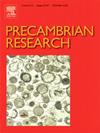Paleoproterozoic orogenic event in the western North China Craton: Insights from zircon U-Pb-Lu-Hf isotopes and geochemistry of meta-supracrustal rocks in the Beidashan complex, Alxa block
IF 3.2
2区 地球科学
Q2 GEOSCIENCES, MULTIDISCIPLINARY
引用次数: 0
Abstract
Recent studies have highlighted Paleoproterozoic magmatic and metamorphic events within the Alxa block. Although these geological records are generally believed to be associated with Paleoproterozoic orogenic events, the nature and location of the potential orogenic belt remains poorly understood. In this paper, we systematically investigate U-Pb-Lu-Hf isotope analyses of detrital zircons, alongside whole-rock major and trace element analyses from a suite of Paleoproterozoic meta-supracrustal rocks in the Beidashan complex, to provide new insights into this enigmatic orogenic event.
The formation age of the upper sequence of the meta-supracrustal rock suite is constrained to 1.89 ∼ 1.83 Ga, with detrital zircons exhibiting a unimodal distribution centered at ∼ 1.96 Ga and Hf model age peaks at ∼ 2.4 Ga and 2.6 ∼ 2.7 Ga. In contrast, the deposition age of the lower sequence is constrained to 2.08 ∼ 2.05 Ga, with detrital zircons show age peaks at ca. 2.20 Ga, 2.30 Ga and 2.41 Ga, and a Hf model age peak at ∼ 2.95 Ga. Geochemical analyses reveal that amphibolites from the upper sequence are enriched in light rare earth elements (LREE) and show negative Nb and Ta anomalies. Conversely, amphibolites from the lower sequence display relatively low REE differentiation and are depleted in high field strength elements (HFSE). Both sequences exhibit Nb-Ta troughs, characteristic of typical continental arc basalts and andesites. The amphibolites from the upper sequence are more enriched in LREE, which likely indicates their formation in a late-orogenic environment.
The detrital zircons from the Beidashan complex exhibit age distributions and Lu-Hf isotope compositions that align with the Archean-Paleoproterozoic magmatic rocks exposed in the Alxa block. This alignment suggests that the Beidashan, Longshoushan and Bayanwulashan regions to the south of the Alxa block likely served as the source area for the lower sequence, while the Diebusige region to the north may be the provenance for the upper sequence. This provenance shift around ∼1.9 Ga likely reflects the uplift of an accretionary orogen north to the research region, which not only introduced new juvenile material into the sedimentary record but also stopped the original material supply from the south. Therefore, we propose that the Alxa block experienced an orogenic event north to the Beidashan complex during 2.1 to 1.8 Ga, potentially related to the subduction and collision between an unknown continent and the Alxa block along its northern margin, contributing to the formation of the Columbia supercontinent.
华北克拉通西部古元古代造山事件:阿拉善地块北大山杂岩体锆石U-Pb-Lu-Hf同位素及变质表壳岩石地球化学特征
最近的研究重点是阿拉善地块内的古元古代岩浆和变质事件。虽然这些地质记录通常被认为与古元古代造山带事件有关,但对潜在造山带的性质和位置仍然知之甚少。本文系统地研究了北大山杂岩中一套古元古代变质壳上岩的锆石U-Pb-Lu-Hf同位素分析,以及全岩主量元素和微量元素分析,以期为这一神秘的造山事件提供新的认识。变质表壳岩套上层序的形成年龄限制在1.89 ~ 1.83 Ga,碎屑锆石以~ 1.96 Ga为中心呈单峰分布,Hf模式年龄峰值在~ 2.4 Ga和2.6 ~ 2.7 Ga。下层序沉积年龄限制在2.08 ~ 2.05 Ga,碎屑锆石年龄峰值约为2.20 Ga、2.30 Ga和2.41 Ga, Hf模式年龄峰值为~ 2.95 Ga。地球化学分析表明,上层序角闪岩富集轻稀土元素(LREE),呈现负Nb、负Ta异常。相反,下层序角闪岩的稀土分异程度相对较低,且在高场强元素(HFSE)中处于亏缺状态。两个层序均表现出Nb-Ta槽,具有典型的大陆弧玄武岩和安山岩特征。上层序角闪岩轻稀土元素较富集,可能形成于晚造山环境。北大山杂岩碎屑锆石的年龄分布和Lu-Hf同位素组成与阿拉善地块出露的太古宙-古元古代岩浆岩一致。这表明阿拉善地块以南的北大山、龙首山和巴音乌拉山地区可能是下层序的物源区,而北部的迪布西格地区可能是上层序的物源区。这种物源转移可能反映了研究区北部增生造山带的隆升,这不仅为沉积记录引入了新的幼年物质,而且阻止了来自南方的原始物质供应。因此,我们认为阿拉善地块在2.1 ~ 1.8 Ga期间在北大山杂岩以北经历了一次造山事件,可能与未知大陆与阿拉善地块北缘的俯冲碰撞有关,从而导致了哥伦比亚超大陆的形成。
本文章由计算机程序翻译,如有差异,请以英文原文为准。
求助全文
约1分钟内获得全文
求助全文
来源期刊

Precambrian Research
地学-地球科学综合
CiteScore
7.20
自引率
28.90%
发文量
325
审稿时长
12 months
期刊介绍:
Precambrian Research publishes studies on all aspects of the early stages of the composition, structure and evolution of the Earth and its planetary neighbours. With a focus on process-oriented and comparative studies, it covers, but is not restricted to, subjects such as:
(1) Chemical, biological, biochemical and cosmochemical evolution; the origin of life; the evolution of the oceans and atmosphere; the early fossil record; palaeobiology;
(2) Geochronology and isotope and elemental geochemistry;
(3) Precambrian mineral deposits;
(4) Geophysical aspects of the early Earth and Precambrian terrains;
(5) Nature, formation and evolution of the Precambrian lithosphere and mantle including magmatic, depositional, metamorphic and tectonic processes.
In addition, the editors particularly welcome integrated process-oriented studies that involve a combination of the above fields and comparative studies that demonstrate the effect of Precambrian evolution on Phanerozoic earth system processes.
Regional and localised studies of Precambrian phenomena are considered appropriate only when the detail and quality allow illustration of a wider process, or when significant gaps in basic knowledge of a particular area can be filled.
 求助内容:
求助内容: 应助结果提醒方式:
应助结果提醒方式:


